|
Kingdom of Scotland Rìoghachd na h-Alba The
Kingdom of Scotland (Gaelic: Rìoghachd na h-Alba, Scots: Kinrick o Scotland) was a sovereign state in Northern Europe
that existed from 843 until 1707. Its territories expanded and shrank throughout its history, but eventually came to occupy
the northern third of the island of Great Britain sharing a land border to the south with the Kingdom of England. In 1603,
James VI of Scotland became King of England, joining Scotland with England in a personal union. 
In 1707, the two kingdoms were united to form the Kingdom of Great Britain, under the terms of the Acts of
Union. Since the final capture of the Royal Burgh of Berwick by the Kingdom of England in 1482 (following the annexation of
the Northern Isles from the Kingdom of Norway in 1472) the territory of the Kingdom of Scotland has corresponded to that of
modern-day Scotland, bounded by the North Sea to the east, the Atlantic Ocean to the north and west, and the North Channel
and Irish Sea to the southwest. Apart from the mainland, the Kingdom of Scotland consisted of over 790 islands. Edinburgh,
the capital, was preceded by the towns of Scone, Dunfermline and Stirling as the country's capital. The population of the
Kingdom of Scotland in 1701, six years before the passing of the Acts of Union, was approximately 1.1 million.
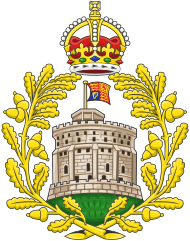 The
History of the House of Windsor The
House of Windsor is the royal house of the Commonwealth realms. It was founded by King George V by royal proclamation on the
17 July 1917, when he changed the name of his family from the German Saxe-Coburg and Gotha (a branch of the House of Wettin)
to the English Windsor, due to the anti-German sentiment in the United Kingdom during World War I. Currently, the most prominent
member of the House of Windsor is Queen Elizabeth II, the reigning monarch of the Commonwealth realms. 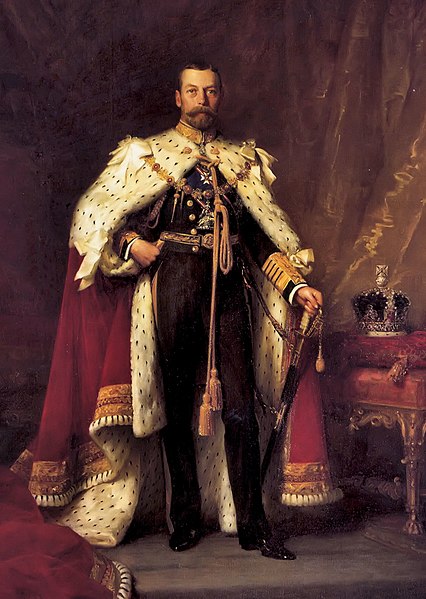
Edward VII, and, in
turn, his son, George V were members of the House of Saxe-Coburg and Gotha, a German ducal family, by virtue of their descent
from Albert, Prince Consort, husband of Queen Victoria. High anti-German sentiment amongst the people of the British Empire
during World War I reached a peak in March 1917, when the Gotha G.IV, a heavy aircraft capable of crossing the English Channel
began bombing London directly. The aircraft became a household name, and the name Gotha was part of the name of the royal
family, Saxe-Coburg-Gotha. These bombings were coupled with the abdication of King George's first cousin, Nicholas II, the
Tsar of Russia on 15 March 1917, which raised the spectre of the eventual abolition of all the monarchies in Europe. The King
and his family were finally convinced to abandon all titles held under the German Crown, and to change German titles and house
names to anglicised versions. Hence, on 17 July 1917, a royal proclamation issued by George V declared: Now, therefore, We, out of Our Royal
Will and Authority, do hereby declare and announce that as from the date of this Our Royal Proclamation Our House and Family
shall be styled and known as the House and Family of Windsor, and that all the descendants in the male line of Our said Grandmother
Queen Victoria who are subjects of these Realms, other than female descendants who may marry or may have married, shall bear
the said Name of Windsor Upon
hearing that his cousin had changed the name of the British royal house to Windsor, German Emperor Wilhelm II remarked jokingly
that he planned to see Shakespeare's play The Merry Wives of Saxe-Coburg-Gotha.The name had a long association with British
royalty, through the town of Windsor, Berkshire and Windsor Castle, a link reflected in the Round Tower of Windsor Castle
being the basis of the badge of the House of Windsor. Also in 1917 Prince Louis of Battenberg adopted the surname Mountbatten,
a partial translation into English. Prince Louis is the maternal grandfather of Prince Philip, Duke of Edinburgh. From 1917
to 1919, George V also stripped 15 of his German relations - most of whom belonged to the House of Hanover - of their British
titles and styles of prince and princess. 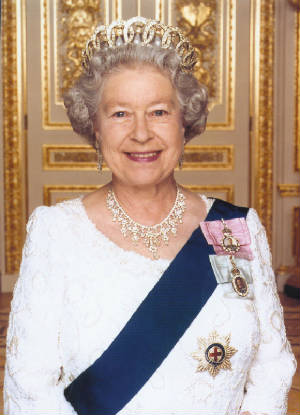
Descendants
of Elizabeth II When
Princess Elizabeth (as she then was) married Prince Philip of Greece and Denmark, the standard practice would be to adopt
the name of his royal house. Because he was a prince, Prince Philip did not have a surname but he was of the House of Schleswig-Holstein-Sonderburg-Glücksburg,
a branch of the House of Oldenburg, and that ruled or rules as Kings of Greece, Denmark and Norway. Not wishing to repeat
the difficulties of three decades previous, before his marriage Prince Philip renounced his titles and adopted the surname
Mountbatten, the literal translation of the German Battenberg that his maternal grandfather had adopted in 1917. The Mountbatten
- Battenberg name refers to Battenberg, a small town in Hesse. 
On 9 April 1952, Queen Elizabeth
II officially declared her "Will and Pleasure that I and My children shall be styled and known as the House and Family
of Windsor, and that my descendants who marry and their descendants, shall bear the name of Windsor." On 8 February 1960,
the Queen confirmed that she and her children would continue to be known as the House and Family of Windsor, as would any
agnatic descendants who enjoy the style of Royal Highness, and the title of Prince or Princess. Still, Elizabeth also decreed
that her agnatic descendants who do not have that style and title would bear the surname Mountbatten-Windsor. Any future monarch
can change the dynastic name through a similar royal proclamation, as royal proclamations do not have statutory authority.   
The
History of the House of Wettin The House of Wettin is a dynasty of German counts, dukes,
prince-electors (Kurfürsten) and kings that once ruled the area of today's German states
of Saxony, the Saxon part of Saxony-Anhalt, and Thuringia for more than 800 years as well as holding
at times the kingship of Poland. Agnates of the House of Wettin have, at various times, ascended
the thrones of Great Britain, Portugal, Bulgaria, Poland, Saxony, and Belgium; of these, only the British and Belgian
lines retain their thrones today. The oldest member of the House of Wettin who is known for certain
was Thiedericus (died 982), who was probably based in the Liesgau (located at the western edge
of the Harz). Around 1000, as part of the German conquest of Slavic territory, the family acquired
Wettin Castle, after which they named themselves. Wettin Castle is located in Wettin in the Hosgau
on the Saale River. Around 1030, the Wettin family received the Eastern March as a fief. The
prominence of the Wettin family in the Slavic marches caused Emperor Henry IV to invest them with
the March of Meissen as a fief in 1089. The family advanced over the course of the Middle Ages: in
1263 they inherited the landgraviate of Thuringia (though without Hesse), and in 1423 they were invested with the
Duchy of Saxony, centred at Wittenberg,thus becoming one of the prince-electors of the Holy Roman
Empire.  The family divided into two ruling
branches in 1485 when the sons of Frederick II, Elector of Saxony divided the territories hitherto
ruled jointly. The elder son Ernest, who had succeeded his father as Prince-elector, received
the territories assigned to the Elector (Electoral Saxony) and Thuringia, while his younger brother
Albert obtained the March of Meissen, which he ruled from Dresden. As Albert ruled under the title
of "Duke of Saxony", his possessions were also known as Ducal Saxony. The older, Ernestine
branch remained predominant until 1547 and played an important role in the beginnings of the
Protestant Reformation. Their predominance ended in the Schmalkaldic War, which pitted the Protestant Schmalkaldic
League against Emperor Charles V. Although itself Protestant, the Albertine branch rallied to the Empire's
cause; Charles V rewarded them by forcing the Ernestines to sign away their rights to the Electoral
title and lands to the Albertines. 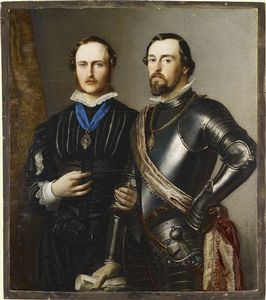
The Ernestine line was thereafter
restricted to Thuringia, and its dynastic unity swiftly crumbled. The Albertine Wettin maintained
most of the territorial integrity of Saxony, preserving it as a significant power in the region,
and using small appanage fiefs for their cadet branches, few of which survived for significant
lengths of time. The Ernestine Wettin, on the other hand, repeatedly subdivided their territory,
creating an intricate patchwork of small duchies and counties in Thuringia. The junior Albertine branch ruled as Electors (1547-1806) and Kings of Saxony (1806-1918)
and also played a role in Polish history: two Wettin were Kings of Poland (between 1697-1763)
and a third ruled the Duchy of Warsaw (1807-1814) as a satellite of Napoleon. After the Napoleonic
Wars, the Albertine branch lost about 40% of its lands, including the old Electoral Saxony, to
Prussia, restricting it to a territory coextensive with the modern Saxony. 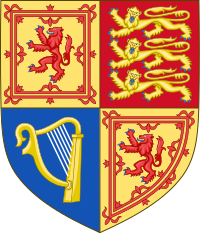
Monarchs of Great Britian -1707 - Present House of Stuart Queen Anne had
been queen of England, Scotland and Ireland since 8 March 1702, and so became Queen of Great Britain upon the Union of England
and Scotland. | Name | Portrait |
Birth | Marriages | Death | Claim |
Anne
1 May 1707 -1 August
1714 | | 6 February 1665
St. James's Palace
daughter of James II and VII and Anne Hyde | George of Denmark
St. James's Palace
28 July 1683
17 children |
1 August 1714
Kensington Palace
aged 49 |
daughter of James II and VII (cognatic primogeniture;
Bill of Rights 1689); Queen of England and Scotland upon the Union; (Treaty of Union and Acts of Union 1707) |
House of Hanover The Hanoverian succession came about as a result of the Act of Settlement 1701, passed by the Parliament
of England. In return for access to the English plantations in North America, the Hanoverian succession and the Union were
ratified by the Parliament of Scotland in 1707. After the death of Anne with no living children, George I, the son of Sophia
of Hanover, granddaughter of James VI of Scotland and I of England through his daughter Elizabeth of Bohemia, was the closest
Protestant heir to the throne. | Name | Portrait | Birth |
Marriages | Death | Succession right | George I
1 August 1714 -
11 June 1727 |  | 28 May 1660
Leineschloss
son of Ernest Augustus, Elector of Brunswick-Lüneburg and Sophia of Hanover | Sophia Dorothea of Brunswick-Lueneburg-Celle
21 November 1682
2 children | 11 June 1727
Osnabrück
aged 67 | son of Sophia
of Hanover, granddaughter of James I & VI; (Act of Settlement 1701 and Acts of Union 1707) |
George II
11 June 1727 -
25 October 1760 |
 | 30 October 1683
Herrenhausen
son of George I and Sophia Dorothea of Brunswick-Lueneburg-Celle | Caroline of Ansbach
22 August 1705
8 children | 25 October 1760
Kensington Palace
aged
76 | son of George I |
George III
25 October 1760 -
29
January 1820 | 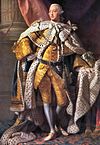 | 4 June 1738
Norfolk House
son of Frederick, Prince of Wales and Princess Augusta of Saxe-Gotha | Charlotte of Mecklenburg-Strelitz
St James's Palace
8 September
1761
15 children | 29 January
1820
Windsor Castle
aged 81 | grandson
of George II | George IV
29 January 1820 -
26 June 1830
(Prince Regent since 1811) | 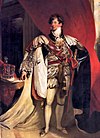 | 12 August 1762
St James's Palace
son of George III and Charlotte of Mecklenburg-Strelitz | (1) Maria Anne Fitzherbert
Park Lane
15 September 1785
(2) Caroline
of Brunswick
St James's Palace
8 April 1795
1 daughter | 26 June 1830
Windsor
aged 67 | first son of George III | William IV
26 June 1830 -
20 June 1837 |
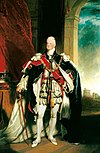 | 21 August 1765
Buckingham Palace
son of George III and Charlotte of Mecklenburg-Strelitz | Adelaide of Saxe-Meiningen
Kew Palace
13 July 1818
2 children |
20 June 1837
Windsor Castle
aged 71 | third son of George III |
Victoria
20 June 1837 -
22 January
1901 | 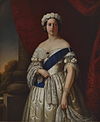 | 24 May 1819
Kensington Palace
daughter of Prince Edward, Duke of Kent and Strathearn and Princess Victoria of Saxe-Coburg-Saalfeld |
Albert of Saxe-Coburg and Gotha
St James's Palace
10 February 1840
9 children | 22
January 1901
Osborne House
aged 81 | granddaughter of George III (by his fourth son) | House of Saxe-Coburg and Gotha Although
he was the son and heir of Victoria, Edward VII inherited his father's names and is therefore counted as inaugurating a new
royal house. | Name | Portrait |
Birth | Marriages | Death | Succession
right | Edward VII
22 January 1901 -
6 May 1910 |  | 9 November 1841
Buckingham Palace
son of Victoria and Prince Albert of Saxe-Coburg-Gotha | Alexandra of Denmark
St George's Chapel
10 March 1863
6 children | 6 May 1910
Buckingham
Palace
aged 68 | son
of Queen Victoria |
House of Windsor
The house name Windsor was adopted in 1917,
during World War I. It was changed from Saxe-Coburg-Gotha because of wartime anti-German sentiment in the United Kingdom.
| Name |
Portrait | Birth | Marriages | Death |
Succession right |
George V
6 May 1910 -
20 January 1936 |
 | 3 June 1865
Marlborough House
son of Edward VII and Alexandra of Denmark | Mary of Teck
St James's Palace
6 July 1893
6 children |
20 January 1936
Sandringham House
aged 70 | son of Edward VII |
Edward VIII
20 January -
11 December
1936 (abdicated) | | 23
June 1894
White Lodge
son of George V and Mary of Teck | Wallis Warfield Simpson
Château de Candé
3 June
1937
no children | 28 May 1972
Neuilly-sur-Seine
aged 77 | son
of George V | George VI
11 December 1936 -
6 February 1952 | | 14 December 1895
Sandringham House
son of George V and Mary of Teck |
Elizabeth Bowes-Lyon
Westminster Abbey
26 April 1923
2 children | 6
February 1952
Sandringham House
aged 56 | son
of George V | Elizabeth
II
6 February
1952 - present |  | 21 April 1926
Mayfair
daughter of George VI and Elizabeth Bowes-Lyon | Philip of Greece and Denmark
Westminster Abbey
20 November 1947
4 children | Incumbent |
daughter of George VI |

Blazon of the Royal Arms This table breaks down the official blazons to enable comparison
of the differences between the general coat and the coat used in Scotland.
| Everywhere except Scotland |
Scotland |
| Quarterly I and IV |
Gules three lions passant gardant in pale Or armed and
langued Azure | Or a lion rampant Gules
armed and langued Azure within a double tressure flory-counter-flory of the second | | II | Or a lion rampant Gules armed and langued Azure within a double tressure flory-counter-flory
of the second | Gules three lions passant
gardant in pale Or armed and langued Azure | | III | Azure a harp Or stringed Argent | | Surrounded by | The Order of the Garter | The
collar of the Order of the Thistle | | Crest | Upon
the Royal helm the imperial crown Proper, thereon a lion statant gardant Or imperially crowned Proper |
Upon the Royal helm the crown of Scotland Proper, thereon
a lion sejant affronté Gules armed and langued Azure, Royally crowned Proper holding in his dexter paw a sword and
in his sinister a sceptre, both Proper | | Supporters |
Dexter
a lion rampant gardant Or imperially crowned Proper, sinister a unicorn Argent, armed, crined and unguled Or, gorged with
a coronet Or composed of crosses patée and fleurs de lis a chain affixed thereto passing between the forelegs and
reflexed over the back also Or |  Dexter a unicorn Argent Royally crowned
Proper, armed, crined and unguled Or, gorged with a coronet Or composed of crosses patée and fleurs de lis a chain
affixed thereto passing between the forelegs and reflexed over the back also Or holding the standard of Saint Andrew, sinister
a lion rampant gardant Or imperially crowned Proper holding the standard of Saint George |
| Motto | Dieu et mon Droit (French) | In My Defens God Me Defend, abbr. In Defens (Scots) |
| Order Motto |
Garter: Honi soit qui mal y pense (Old French) |
Thistle: Nemo me impune lacessit (Lati |
The Family Titles and Styles
The present members of this family bear the title Prince or Princess of Great Britain and Northern Ireland together
with the formal appellation of His or Her Royal Highness, so long as they are children or grandchildren of a sovereign. Untitled
members bear the surname Windsor, or Mountbatten-Windsor in the case of the descendants of Queen Elizabeth II.
The Genealogy of the Royal House Georg Ludwig, Elector of Hannover and Duke of Braunschweig-Lüneburg,
succeeded his cousin Queen Anne as GEORGE I, King of Great Britain and Ireland 1 Aug 1714; he was b.Osnabrück 28 May
1660 and d.nr Osnabrück 11 Jun 1727; he m.Celle 21 Nov 1682 (separated 1694) Sophia Dorothea Dss of Braunschweig-Lüneburg
(Celle 5 Sep 1666-Ahlden 2 Nov 1726) 1a) GEORGE II Augustus, King of Great Britain and Ireland,
Elector of Hannover, Duke of Braunschweig-Lüneburg (Hannover 30 Oct 1683-Kensington Palace 25 Oct 1760); m.Hannover 22
Aug 1705 Karoline Margravine of Brandenburg-Ansbach (Ansbach 1 Mar 1683-St.James's Palace 20 Nov 1737) 1b) Frederick Lewis, Pr of Wales (Hannover 20 Jan 1707-Leicester
House 20 Mar 1751); m.St.James's Palace 8 May 1736 Auguste Pss of Saxe-Gotha (Gotha 30 Nov 1719-Carlton House 8 Feb 1772)
1c) Augusta, Pss Royal (St.James's Palace 31 Jul 1737-London
23 Mar 1813); m.St.James's Palace 16 Jan 1764 Karl II, Duke of Braunschweig (Wolfenbüttel 9 Oct 1735-Altona 10 Nov 1806) 2c) GEORGE III William Frederick, King of Great Britain, Ireland
and Hannover, Duke of Braunschweig-Lüneburg (Norfolk House 4 Jun 1738-Windsor Castle 29 Jan 1820); St.James's Palace
8 Sep 1761 Charlotte Dss of Mecklenburg-Strelitz (Mirow 19 May 1744-Kew Palace 17 Nov 1818) 1d) GEORGE IV Augustus Frederick, King of Great Britain, Ireland
and Hannover, Duke of Braunschweig-Lüneburg (St.James's Palace 12 Aug 1762-Windsor Castle 26 Jun 1830); m.St.James's
Palace 8 Apr 1795 Caroline Dss of Braunschweig (Wolfenbüttel 17 May 1768-Brandenburg House 7 Aug 1821); George IV went
through a form of marriage in London on 21 Dec 1785 with Mary Anne Smythe, Mrs. Fitzherbert, but, this marriage, being in
contravention of the Royal Marriages Act, was considered legally void ab initio 1e) Charlotte Augusta (Carlton House 7 Jan 1796-Claremont
House, Esher, Surrey 6 Nov 1817); m.Carlton House 2 May 1816 Leopold Pr of Saxe-Coburg-Gotha [later, King of the Belgians] (Coburg 16 Dec 1790-Laeken 10 Dec 1865) 2d) Frederick Augustus, Duke of York and Albany, etc (Buckingham
House 16 Aug 1763-Rutland House 5 Jan 1827); m.Berlin 29 Sep 1791 and in London 24 Nov 1791 Friederike Pss of Prussia (Potsdam
7 May 1767-Oatlands Park 6 Aug 1820) 3d) WILLIAM IV Henry, King of Great Britain, Ireland and Hannover,
Duke of Braunschweig-Lüneburg (Buckingham House 21 Aug 1765-Windsor Castle 20 Jun 1837); m.Kew Palace 11 Jul 1818 Adelheid
Pss of Saxe-Meiningen (Meiningen 13 Aug 1792-Bentley Priory 2 Dec 1849)
1e) Charlotte Augusta Louisa, b.and d.Hannover
27 Mar 1819
2e) Elizabeth Georgiana Adelaide (St.James's Palace 10 Dec 1820-St.James's Palace 4 Mar 1821)
King William IV had the following natural issue by his mistress, Dorothy Bland, known as "Mrs.Jordan"
3e) George Augustus
Frederick Fitzclarence, Earl of Munster (London 29 Jan 1794-suicide London 20 Mar 1842); m.18 Oct 1819 Mary Wyndham (d.London
3 Dec 1842)
1f) Lady Adelaide Georgiana Fitzclarence (Westminster 28 Aug 1820-Hove 11 Oct 1883)
2f)
Lady Augusta Margaret Fitzclarence (Bushy 29 Jul 1822-Gimmersta 5 Sep 1846); m.Paris 10 Apr 1844 Baron Knut Philip de Bonde
(Ericsberg 9 Mar 1815-Stockholm 17 Oct 1871)
3f) William George Fitzclarence, 2d Earl of Munster (Bushy 19 May
1824-Brighton 30 Apr 1901); m.London 17 Apr 1855 Wilhelmine Kennedy-Erskine (Scotland 27 Jun 1830-Brighton 9 Oct 1906)
1g) Edward, Viscount Fitzclarence (London 29 Mar 1856-22 Nov 1870)
2g) Hon.Lionel Frederick Archibald
Fitzclarence (London 24 Jul 1857-24 Mar 1863)
3g) Geoffrey George Gordon Fitzclarence, 3d Earl of Munster (London
18 Jul 1859-South Africa 2 Feb 1902)
4g) Hon.Arthur Falkland Manners Fitzclarence (18 Oct 1860-20 Apr 1861)
5g) Aubrey Fitzclarence, 4th Earl of Munster (7 Jun 1862-1 Jan 1928)
6g) Hon William George Fitzclarence
(17 Sep 1864-4 Oct 1899); m.1887 Charlotte Elizabeth Williams (d.5 Sep 1902)
1h) Dorothy Margaret Aline Fitzclarence
(23 Sep 1888-1952); m.Shoreham 11 Sep 1909 Cecil Cadogan Elborough (1886-1953)
2h) Wilhelmine Violet Eileen Fitzclarence
(17 Jul 1894-1962); m.19 Jan 1918 Cecil John Cokayne Maunsell (2 Feb 1881-11 Feb 1948)
7g) Hon.Harold Edward Fitzclarence
(15 Nov 1870-28 Aug 1926); m.14 May 1902 Frances Isabel Eleanor Keppel (20 Jul 1874-1 Feb 1951)
1h) Lady Wilhelmina
Joan Mary Fitzclarence (17 Nov 1904-Little Massingham 1992); m.1st 21 Apr 1928 Oliver Birkbeck (6 May 1893-13 May 1952); m.2d
28 Apr 1961 Henry John Cator (23 Jan 1926-27 Mar 1965)
2h) Geoffrey William Richard Hugh Fitzclarence, 5th Earl
of Munster (17 Feb 1906-27 Aug 1975); m.9 Jul 1928 Hilary Wilson (19 Mar 1903-Sandhills, Bletchingley 29 Oct 1979)
8g) Lady Lilian Adelaide Katherine Mary Fitzclarence (10 Dec 1873-15 Jul 1948); m.17 Jan 1893 William Arthur Edward Boyd
(1855-6 Dec 1931)
9g) Lady Dorothea Augusta Fitzclarence (5 May 1876-28 Jan 1942); m.20 Nov 1899 Chandos Brydges
Lee-Warner (11 Jun 1863-1 Oct 1944)
4f) Hon.Frederick Charles George Fitzclarence-Hunloke (London 1 Feb 1826-Kensington
17 Dec 1878); m.2 Dec 1856 Hon.Adelaide Sidney (London 1 Jun 1826-Chelsea 20 Sep 1904)
5f) Lady Mary Gertrude
Fitzclarence (London 31 Oct 1834-1834)
6f) Hon.George Fitzclarence (Brighton 15 Apr 1836-Hillingdon 24 Mar 1894);
m.5 Jul 1864 Lady Maria Henrietta Scott (Bishopscourt, Ireland 10 Oct 1841-Littlehampton 27 Jul 1912)
1g) Charles
Edward Fitzclarence (8 May 1865-k.a.Ypern 12 Nov 1914); m.Cairo 20 Apr 1898 Violet Spencer-Churchill (London 13 Jun 1864-22
Dec 1941)
1h) Edward Charles Fitzclarence, 6th Earl of Munster (3 Oct 1899-15 Nov 1983); m.1st 30 July 1925 (div
1930) Monica Grayson (d.5 Oct 1958); m.2d 28 Sep 1939 Vivian Schofield (d.7 May 2008)
1i) Anthony Charles Fitzclarence,
7th Earl of Munster (21 Mar 1926-30 Dec 2000); m.1st 28 Jul 1949 (div 1966) Diane Delvigne; m.2d 18 Jun 1966 (div 1979) Pamela
Spooner; m.3d 1979 Dorothy Alexa Maxwell (22 Dec 1924-1995); m.4th Crowhurst, Surrey 3 May 1997 Halina Winska
1j)
Lady Tara Francesca Fitzclarence (b.6 Aug 1952); m.1979 Ross Jean Heffler
2j) Lady Finola Dominique Fitzclarence
(b.6 Dec 1953); m.1981 Jonathan Terence Poynton
3j) [by 2d wife, before m.] Charlotte Catherine Lawrence Mills,
formerly Oonagh Sarah Fitzclarence, b.1964; m.1987 Raymond Burt
4j) Lady Georgina Fitzclarence (b.1966); m.1st
1993 (div 1995) Paul Robert Phillips; m.2d 1997 John Adam
2i) Lady Mary Jill Fitzclarence (6 Feb 1928-1971); m.1st
4 Jun 1953 (div 1960) Melvin Flyer; m.2d 28 Mar 1968 John Welter (31 Oct 1908-1980)
2h) Joan Harriet Fitzclarence
(23 Dec 1901-6 Jan 1971) m.30 Mar 1933 Francis Barchard (k.a.25 Nov 1941)
2g) Edward Fitzclarence (8 May 1865-7
Aug 1897)
3g) William Henry Fitzclarence (17 Feb 1868-24 Nov 1921); m.11 Aug 1908 Hilda Sankey (d.3 Jan 1959)
4g) Lionel Ashley Arthur Fitzclarence (30 Nov 1870-19 Dec 1936); m.16 Jul 1913 Theodora Jack (d.12 Apr 1948)
1h) Mary Theodora Annette Fitzclarence (10 May 1914-14 Aug 2002); m.1948 Adam Gluszkiewicz
5g) Annette Mary
Fitzclarence (15 Jun 1873-7 Jul 1970)
6g) Mary Fitzclarence (7 Aug 1877-9 Feb 1939); m.5 Oct 1905 Frederick Drummond
Vincent Wing (29 Nov 1860-k.a.2 Oct 1915)
7f) Hon.Edward Fitzclarence (London 8 Jul 1837-d.of wounds received
in action at Redan 23 Jul 1855)
4e) Lady Sophia Fitzclarence (London 4 Mar 1795-Kensington Palace 10 Apr 1837);
m.Westminster 13 Aug 1825 Philip Sidney, Lord de l'Isle and Dudley (11 Mar 1800-Penshurst 4 Mar 1851)
5e) Lord
Henry Edward Fitzclarence (Petersham 8 Mar 1797-India Sep 1817)
6e) Lady Mary Fitzclarence (Bushy 19 Dec 1798-13
Jul 1864); m.St.George's, Hanover Square, London 19 Jun 1824 Charles Richard Fox (Brompton, Middlesex 1796/7-Kensington 13
Apr 1873)
7e) Lord Frederick Fitzclarence (Bushy House 9 Dec 1799-nr Poonah, India 30 Oct 1854); m.Kent House,
Knightsbridge, London 19 May 1821 Lady Augusta Boyle (14 Aug 1801-Ford, Northumberland 28 Jul 1876)
1f) Augusta
Fitzclarence (Belfast 1824-Cumbrae 18 Oct 1855)
2f) William Fitzclarence (16 Jul 1827-London 27 Jul 1827)
8e) Lady Elizabeth Fitzclarence (Bushy House 18 Jan 1801-Edinburgh 16 Jan 1856); m.London 4 Dec 1820 William George,
18th Earl of Erroll (21 Feb 1801-London 19 Apr 1846)
9e) Lord Adolphus Fitzclarence (Bushy 17/18 Feb 1802-Newburgh
Priory, Easingwold, E.Yorkshire 17 May 1856)
10e) Lady Augusta Fitzclarence (Bushy 3 Nov 1803-8 Dec 1865); m.1st
Bushy House 5 Jul 1827 Hon.John Kennedy Erskine, of Dun (4 Jan 1802-Pisa 6 Mar 1831); m.2d Windsor Castle 24 Aug 1836 Lord
John Gordon Hallyburton (15 Aug 1799-Hallyburton House 29 Sep 1878)
11e) Lord Augustus Fitzclarence (Bushy House
1 Mar 1805-14 Jun 1854); m.Kensington 2 Jan 1845 Sarah Elizabeth Gordon (Meerut, India 26 Dec 1827-Chelsea 23 Mar 1901)
1f) Dorothea Fitzclarence (Clarges Street, Westminster 27 Oct 1845-15 May 1870); m.17 Mar 1863 Thomas William Goff
(6 Jul 1829-London 3 Jun 1876)
2f) Eva Fitzclarence (Mapledurham 1 Jan 1847-Chelsea 2 Mar 1918)
3f)
Beatrix Fitzclarence (Mapledurham 1 Jan 1847-St.Leonard's-on-Sea 18 Mar 1909)
4f) Augustus Fitzclarence (Mapledurham
13 Feb 1849-Dresden 16 Oct 1861)
5f) Henry Edward Fitzclarence (Mapledurham 19 Jan 1853-19 Feb 1930); m.11 Jun
1879 Mary Isobel Templer Parsons (Galle, Ceylon 18__-17 Jul 1932)
1g) Augustus Arthur Cornwallis Fitzclarence
(16 Mar 1880-k.a.28 Jun 1915); m.7 Apr 1910 Lady Susan Yorke (7 May 1881-21 Aug 1965)
2g) Cynthia Adela Victoria
Fitzclarence (7 Feb 1887-1970); m.11 Jun 1908 Roland George Orred (27 Dec 1886-20 Jun 1963)
6f) Mary Fitzclarence
(Rutland Gate, Westminster Sep 1854-Westminster 14 Mar 1858)
12e) Lady Amelia Fitzclarence (Bushy House 21 Mar
1807-Hutton Rudby, No. Yorkshire 2 Jul 1858); m.Brighton 27 Dec 1830 Lucius Bentinck Cary, Viscount Falkland (5 Nov 1803-Montpelier
12 Mar 1884) 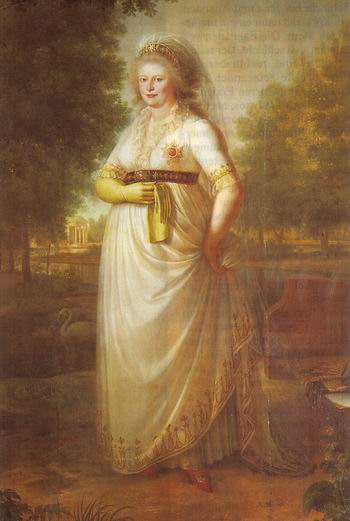 4d) Charlotte Augusta Matilda, Pss Royal (Buckingham House
29 Sep 1766-Ludwigsburg 6 Oct 1828); m.St.James's Palace 18 May 1797 King Friedrich I of Württemberg (Treptow 6 Nov 1754-Stuttgart
30 Oct 1816) 5d) Edward Augustus, Duke of Kent and Strathearn, etc (Buckingham
House 2 Nov 1767-Sidmouth 23 Jan 1820); m.Coburg 29 May 1818 and Kew Palace 11 Jul 1818 Viktoria Fstn zu Leiningen, née
Pss of Saxe-Coburg-Saalfeld (Coburg 17 Aug 1786-Frogmore House, nr Windsor 16 Mar 1861) 1e) Alexandrina VICTORIA, succeeded William IV as Queen of
Great Britain and Ireland (but not Hannover), and was proclaimed Empress of India 1 Jan 1877 (Kensington Palace 24 May 1819-Osborne
House, Isle of Wight 22 Jan 1901); m.St.James's Palace 10 Feb 1840 Albert Pr of Saxe-Coburg-Gotha, cr Pr Consort 1857 (Schloß Rosenau 26 Aug 1819-Windsor Castle 14 Dec 1861) 1f) Victoria Adelaide Mary Louisa, Pss Royal (Buckingham Palace
21 Nov 1840-Friedrichshof 5 Aug 1901); m.St.James's Palace 25 Jan 1858 Emperor Friedrich III of Germany (Neues Palais 18 Oct 1831-Neues Palais 15 Jun 1888) 2f) Albert EDWARD VII, King of Great Britain and Ireland,
Emperor of India, Pr of Saxe-Coburg-Gotha, etc (Buckingham Palace 9 Nov 1841-Buckingham Palace 6 May 1910); m.Windsor Castle
10 Mar 1863 Alexandra Pss of Denmark (Copenhagen 1 Dec 1844-Sandringham 20 Nov 1925) 1g) Albert Victor Christian Edward, Duke of Clarence and Avondale,
etc (Frogmore House, nr Windsor 8 Jan 1864-Sandringham 14 Jan 1892) 2g) GEORGE V Frederick Ernest Albert, succeeded his father
King Edward VII as King of Great Britain and Ireland, Emperor of India; "Ireland" in the title of the British sovereign
was changed to "Northern Ireland" at some point after the separation of Ireland; he renounced on behalf of himself
and his family the German titles they held during the First World War; he was b.at Marlborough House, London 3 Jun 1865 and
d.at Sandringham, Norfolk 20 Jan 1936; he m.at St.James's Palace 6 Jul 1893 Mary Pss von Teck (Kensington Palace 26 May 1867-Marlborough
House 24 Mar 1953) 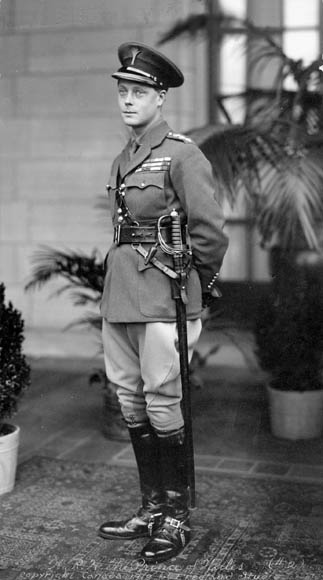 1h) EDWARD VIII Albert Christian George Andrew Patrick David,
King of Great Britain and Ireland, Emperor of India, abdicated 10 Dec 1936, cr Duke of Windsor 8 Mar 1937 and was granted
the style Royal Highness for himself only (White Lodge, Richmond Park, Surrey 23 Jun 1894-Paris 28 May 1972); m.Château
de Candé 3 Jun 1937 Wallis Warfield, Mrs. Simpson (Blue Ridge Summit, Monterey Inn, nr Hagerstown, Pennsylvania 19
Jun 1896-Paris 24 Apr 1986) 2h) Albert Frederick Arthur GEORGE VI, King of Great Britain
and Ireland, Emperor of India, ascended the throne on the abdication of his brother, King Edward VIII, 11 Dec 1936; he relinquished
the title Emperor of India 22 Jun 1948; he was b.York Cottage, Sandringham 14 Dec 1895 and d.at Sandringham 6 Feb 1952; he
m.at Westminster Abbey 26 Apr 1923 Lady Elizabeth Bowes-Lyon (London 4 Aug 1900-Royal Lodge, WIndsor Great Park 30 Mar 2002) 1i) ELIZABETH II Alexandra Mary, Queen of Great Britain and
Northern Ireland, b.London 21 Apr 1926; m.Westminster Abbey 20 Nov 1947 Philip Mountbatten, Duke of Edinburgh, formerly Pr of Greece and Denmark (b.Corfu 10 Jun 1921) 1j) Charles Philip Arthur George, Prince of Wales, b.Buckingham
Palace 14 Nov 1948; m.1st St.Paul's Cathedral 29 Jul 1981 (div 1996) Lady Diana Frances Spencer (Park House, Sandringham 1 Jul 1961-k.in car wreck at Paris 31 Aug 1997); m.2d Windsor 9 Apr 2005 Mrs Camilla Rosemary Parker
Bowles, née Shand, now styled H.R.H. the Duchess of Cornwall (b.London 17 Jul 1947) 1k) William Arthur Philip Louis, cr 29 Apr 2011
Duke of Cambridge, Earl of Strathearn, and Baron Carrickfergus, b.Paddington, London 21 Jun 1982; m.Westminster Abbey 29 Apr
2011 Catherine Elizabeth Middleton (b.Reading 9 Jan 1982) 2k) Henry (Harry) Charles Albert David, b.Paddington, London
15 Sep 1984 2j) Anne Elizabeth Alice Louise, cr 1987 Princess Royal, b.Clarence
House 15 Aug 1950; m.1st Westminster Abbey 14 Nov 1973 (div 1992) Mark Antony Peter Phillips (b.Tetbury, Gloucs 22 Sep 1948);
m.2d Crathie Church, nr Balmoral 12 Dec 1992 Sir Timothy James Hamilton Laurence (b.Camberwell, Surrey 1 Mar 1955)
1k) Peter Mark Andrew Phillips, b.London 15 Nov 1977; m.Windsor Castle 17 May 2008 Autumn Patricia Kelly (b.Montreal 3 May
1978)
1l) Savannah Phillips, b.Gloucestershire Royal Hospital 29 Dec 2010 2k) Zara Anne Elizabeth Phillips, b.London 15 May 1981; m.Canongate
Kirk, Edinburgh 30 Jul 2011 Michael James Tindall (b.Otley, Leeds 18 Oct 1978) 3j) Andrew Albert Christian Edward, cr 1986 Duke of York,
Earl of Inverness and Baron Killyleagh, b.Buckingham Palace 19 Feb 1960; m.Westminster Abbey 23 Jul 1986 (div 1996) Sarah
Margaret Ferguson (b.London 15 Oct 1959) 1k) Beatrice Elizabeth Mary, b.London 8 Aug 1988 2k) Eugenie Victoria Helena, b.London 23 Mar 1990 4j) Edward Antony Richard Louis, Earl of Wessex, b.Buckingham
Palace 10 Mar 1964; m.Windsor Castle 19 Jun 1999 Sophie Helen Rhys-Jones (b.Oxford 20 Jan 1965) 1k) Louise Alice Elizabeth Mary (b.Frimley Park Hospital,
Surrey 8 Nov 2003) 2k) James Alexander Philip Theo, Viscount Severn (b.Frimley
Park Hospital 17 Dec 2007)
|

